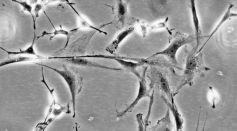Tags: Cells

CRISPR Genetic Tool May Switch Genes ‘On’ and ‘Off’ Using Nanobodies

Lab-Grown Meat for Pets? Experts Explain How
Researchers Shed Light on How Cells Keep Moving Without Sticking to Surfaces
Rare Four-Stranded DNA Unraveled for the First Time

Drug Combination Could Lower High Sugar Levels and Control Weight Gain in Diabetic People
How Do Epithelial Cells Protect the Skin From Viruses?
Tiny Microbial Factories That Produces Hydrogen By Photosynthesis
Aging Theory Finally Proven After 15 Years

Giving Cells a "Squeeze" Makes Them Divide Faster
Human Cells Look Younger Than Chimp's Despite Sharing 99% of Genetic Code
Astrocytes Found Responsible for Nerve Cell Death in Glaucoma
Anti-Hepatitis C Defense System Used to Treat COVID-19, Scientists Say
Cellular Cell Clocks May Be Real, New Research Reveals
OHSU Research Could Lead to New Therapies to Heal Nervous System Disorders
A Unique Tool for Live-Cell Imaging
Synthesizing Chemical-Sensing Cells from Scratch
A New Microscopy System for Imaging Cells from Inside
SpaceX Delivered Human Organs to ISS
Zombie-like Cells Can Help Quicken Drug Discovery
Cell-sized micro-robots to make an incredible journey in the human body
Most Popular

Recycling Myths vs Facts: What Actually Gets Recycled and How to Do It Right

What Is Conservation Biology? Key Strategies to Protect Species and Habitats

Allergies Explained: What Happens in Your Body During an Allergic Reaction

Types of Pollution: Air, Water, Soil, Noise, and Their Health Effects





